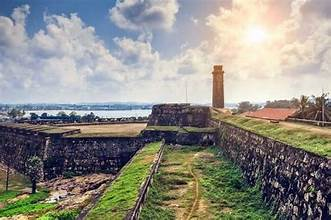…Galle Fort…
Galle Fort: A Timeless Relic of Sri Lanka’s Colonial Past
Introduction Galle Fort, located on the southwestern coast of Sri Lanka, is one of the country’s most iconic and well-preserved colonial-era landmarks. This ancient fortress, which stands as a UNESCO World Heritage Site, is a testament to Sri Lanka’s colonial past, blending Portuguese, Dutch, and British influences with local culture and architecture. The fort’s unique combination of historical, architectural, and cultural elements makes it a captivating destination for history enthusiasts and travelers alike.
Historical Background The history of Galle Fort dates back to the early 16th century when the Portuguese first arrived on the island. In 1588, they began constructing the original fortifications, primarily for defensive purposes. Positioned strategically by the Indian Ocean, Galle was a key port, and the Portuguese sought to secure their control over the lucrative spice trade routes.
In 1640, the Dutch East India Company (VOC) captured Galle from the Portuguese and expanded the fort significantly, creating the layout that largely remains today. They rebuilt the fort with thick, sturdy walls and 14 bastions, designed to withstand attacks both from sea and land. The Dutch also brought European town planning principles to Galle, building churches, administrative offices, homes, and warehouses, all within the protective walls of the fort.
When the British took control of Sri Lanka in 1796, they made relatively few changes to Galle Fort, preserving much of the Dutch-built infrastructure. Under British rule, the fort continued to serve as an important administrative and trading center until Colombo became the dominant port.
Architecture and Design Galle Fort is renowned for its unique blend of European colonial architecture and South Asian influences. The thick granite and coral walls that encircle the fort were constructed to defend against attacks and the harsh conditions of the sea. The design includes ramparts and bastions with names such as Sun, Moon, and Star, which served as lookout points during the colonial period.
Inside the fort, the streets are laid out in a grid pattern, a hallmark of Dutch town planning. The architecture reflects a range of styles, from simple, elegant Dutch townhouses with gabled roofs to more elaborate British-era buildings with neoclassical features. Many of the buildings have been restored and repurposed into boutique hotels, cafes, and shops, maintaining their historical charm while adapting to modern needs.
Key architectural landmarks within Galle Fort include:
- Dutch Reformed Church: Built in 1755, this church is one of the oldest in Sri Lanka. It features gravestones embedded in the floor and a simple yet elegant design reflecting Dutch Protestant aesthetics.
- Old Dutch Hospital: This building, once used as a hospital by the Dutch, has been transformed into a stylish shopping and dining complex, retaining much of its colonial architecture.
- Galle Lighthouse: Located on the southern end of the fort, the Galle Lighthouse is a striking coastal landmark. Originally built by the British in 1848, it continues to guide ships to this day.
- Clock Tower: The British-built Clock Tower, constructed in 1883, stands at the highest point of the fort and offers panoramic views of the town and ocean.
Cultural Significance Beyond its architectural grandeur, Galle Fort is a living heritage site. Its streets are home to a vibrant community of residents who embody the fusion of cultures that have shaped the fort’s history. While many of the inhabitants are descendants of Dutch, Portuguese, and British settlers, there is also a significant Muslim community, known for their role in the fort’s trading history.
The fort regularly hosts cultural festivals, including the Galle Literary Festival, one of South Asia’s most prestigious literary events. The festival attracts international writers, intellectuals, and artists, further enriching the cultural fabric of Galle Fort.
Additionally, Galle Fort’s importance as a trading hub during the colonial era brought a variety of goods, customs, and religions to the region. This is reflected in the fort’s religious diversity, with churches, mosques, and temples coexisting harmoniously within the same space.
Preservation and Modern Relevance In 1988, UNESCO designated Galle Fort as a World Heritage Site, recognizing its outstanding historical and cultural value. This has spurred efforts to preserve the fort’s architectural integrity while balancing the needs of modern residents and businesses.
Today, Galle Fort is a thriving tourist destination, drawing visitors who come to explore its cobblestone streets, colonial buildings, and coastal views. The fort’s charm lies not only in its preserved past but also in its vibrant present, where old and new coexist seamlessly. Visitors can walk along the fort’s ramparts, enjoy a sunset over the Indian Ocean, or browse art galleries and antique shops.
Efforts have been made to maintain the fort’s historical authenticity, with strict regulations on new construction and renovations. However, some concerns remain about the impact of tourism on the local community and the fort’s heritage. Balancing preservation with the pressures of modernization continues to be a challenge for those tasked with protecting this national treasure.
Conclusion Galle Fort is more than just a relic of Sri Lanka’s colonial past; it is a living monument that tells the story of centuries of cultural exchange, trade, and conquest. Its blend of architectural styles, historical significance, and vibrant community life make it a must-visit destination for anyone interested in the rich history of Sri Lanka. As it continues to evolve, Galle Fort stands as a testament to the enduring legacy of Sri Lanka’s colonial history and its unique place in the global heritage landscape.

